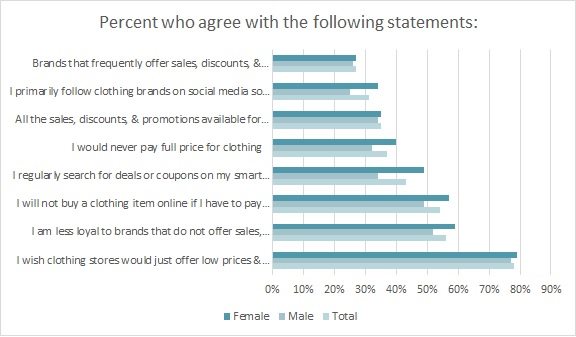Once upon a time in retail, there were category killers — stores so powerful in a particular type of offering, they knocked off their smaller competitors. Then along came an online outfit that started selling books online. It seemed silly: why buy a book online when you could spend an afternoon at Barnes & Noble, curled in a comfy chair, browsing books, and perhaps buying something? Slowly but surely, it was as if that startup, Amazon.com, said, “I’ll see your books, and raise you with electronics, patio furniture, pet supplies, home goods, health and beauty, jewelry, groceries… heck, even TV shows and movie rentals.” Could the apparel industry have ever felt safe?[quote]
Amazon banked on people wanting what they want, as fast as possible, for the best price. The apparel industry has banked on consumers wanting to touch and try on clothes before buying them. But Amazon started backing into the apparel business since 2002, when it allowed stores and brands to sell clothes through its site. And by the end of 2017, it’s estimated it will be the number one seller of apparel and accessories, besting department stores and mass merchants, according to a report from Cowen & Co.
These days, Amazon’s brands range from Lands’ End Cut to Vineyard Vines to Stella McCartney. And in keeping with its fast delivery mantra, last football season Amazon made one-hour deliveries of tailgate supplies — including Levi’s denim — right to the NFL’s San Francisco 49ers’ fans. Also last year, the Silicon Valley giant quietly launched seven in-house apparel brands, including Lark & Ro and James & Erin. And this month, the company was granted a patent for an integrated on-demand apparel manufacturing system, where clothes are quickly made to order entirely by robot only once a customer order is placed. The efficiency of the manufacturing model ensures there are no pre-made stocks of clothes that can fall out of trend in the three-to-six months between being shown to merchandisers and hitting retail.
It’s not just the efficiency that’s mind-boggling, it’s the power and all-encompassing breadth of Amazon’s approach.
“How to deal with Amazon is a question that’s top of mind for everyone,” says Matt Field, co-founder of MakerSights, a predictive analytics consulting firm. “We have a ton of respect for them. No industry should underestimate how Amazon will play in their space. No one can compete with Amazon’s scale. So you have to understand your customer and have a point of view on that season — yet know what your brand means to the customer at that moment.”
MakerSights, which was launched this year, harnesses data for its clients and then, by inviting customers to weigh in, helps them use the analytics for future product design, development and marketing, saving time and money. Its roster already includes Ralph Lauren, Lucky Brand, Taylor Stitch, and True Religion. However, the company is quick to point out that its platform isn’t replacing the human element behind fashion’s creativity.
“Our point of view is fashion should never be crowd sourced,” says Dan Leahy, CEO. “At the same time, there’s a ton of creativity in brands that never sees the light of day because merchants say, ‘This never sold in past so won’t take risk now.’ So we say here’s an opportunity for your creations to see the light of day, by letting the customer give their feedback and then seeing if it’s worth putting the investment behind it. There will never be a perfect crystal ball. But we think we can put brands at ease, by showing them where predictive analytics, intuition, and creativity can be put in play.”
Brands and stores should keep in mind something Amazon likely already knows: The majority of consumers (57%) say they wish shopping for clothing in-store or online was like streaming TV or movies on Netflix, Hulu, etc., where they can get whatever they want, whenever they want it, according to the Cotton Incorporated Lifestyle Monitor™ Survey. This rises significantly among Millennials (71%).

To keep up, L2’s Evan Neufeld, vice president of intelligence, says stores and brands should embrace the “fail fast” point of view, meaning be bold and be quick because the industry is very much in a test and learn phase in its development.
“Amazon’s total market cap is equal to the next eight competitors,” he said at UBM Fashion’s NY Women’s show. “And retailers have to do what they can to keep up. We talk about the amount of data retailers get. And the deployment of beacons in stores gives us the ability to monitor what consumers are doing in the store and target more specific offers to them. The good news is there’s more and more of this data that can personalize the whole shopping experience. The bad news is, the concept of signal to noise becomes important. As you get terabytes of information from your beacons, what does it tell you that’s useful?”
Rather than become overwhelmed by data, he says brands should analyze whether an Amazon Dash button — which makes it easy to order replenishment items — makes sense for their business before investing in it. Also, if stores have a mobile app, does it have an in-store platform to make shopping easier? He suggests arming sales associates with mobile devices for quick product searches as well as adding kiosks to stores for important items, and moving online pickup areas to the front of the store, which adds convenience for the consumer.
“These types of things help you make active choices about what you want to incorporate, as opposed to being overwhelmed by the sheer volume of data you’ll get,” he stated.
When it comes to buying apparel, stores and brands should keep in mind that the top purchasing decisions are fit (97 percent), comfort (96 percent), price (92 percent), and quality (57 percent), according to the Monitor™. Additionally, the majority of consumers (60 percent) still view shopping for clothes in-store as a fun, social activity.
Even luxury is concerned with how to deal with Amazon. Stratist Group’s Jeff Loehr, principal and strategy lead of the consulting firm, says his firm likes to help companies not just think “outside the box,” but create new boxes, especially when trying to stay ahead in today’s hyper competitive retail market.
“You have to think about how you’re going to engage,” he said at a Luxury Marketing Group event that spoke directly toward addressing Amazon in the luxury sector. “We know marketing, digital sales and the definition of luxury is changing. So brands have to think about how they will engage. In the future, Amazon’s Alexa will make buying decisions for us like, ‘Alexa, buy my wife a watch, please.’ So you have to think about how you’ll market to that? Yet omni-channel will still matter so you have to define niches and positioning.”
Also at the Luxury Marketing Group’s event, Bob Shullman, founder of the Shullman Research Center, said luxury brands should not dismiss Amazon as being for the mainstream consumer, as luxury buyers use the shopping site regularly. And he says Alexa will be part of the retail change in the luxury market, as well.
“Alexa will go from 4 million searches up to 30 million in 2017,” he said. “And 6 out of 10 luxury customers are also Amazon customers. Amazon is not truly in the luxury marketplace, yet, but you’ll see some of the high-end brands there. However, Amazon has something no other marketer has — your email and street address. If you take that and merge with Axiom Experience and some of the other databases, you see how they have an incredible capability to target or micro target consumers, perhaps seeing the town where someone lives, the average income on their street and the cars they have.”
He said marketers can benefit from knowing each generation and what they consider to be luxury — whether it’s import sports car or simply more time in their day — as well as key terms that each generation uses to define luxury — like “costly,” “high-end,” “quality,” or “rich.” And the successful brand will be the one who, like Amazon, makes shopping easier.
“To my mind, Amazon didn’t change retailing, they’re changing how people shop,” Shullman said. “Retailing is reacting to what Amazon is doing, which is taking the problems and annoyances out of shopping to make it faster and easier for the consumer.”
